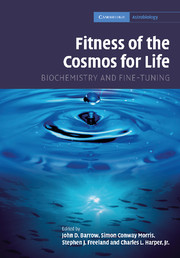Book contents
- Frontmatter
- Contents
- List of contributors
- Foreword: The improbability of life
- Preface
- Acknowledgments
- Part I The fitness of “fitness”: Henderson in context
- Part II The fitness of the cosmic environment
- Part III The fitness of the terrestrial environment
- Part IV The fitness of the chemical environment
- 16 Creating a perspective for comparing
- 17 Fine-tuning and interstellar chemistry
- 18 Framing the question of fine-tuning for intermediary metabolism
- 19 Coarse-tuning in the origin of life?
- 20 Plausible lipid-like peptides: prebiotic molecular self-assembly in water
- 21 Evolution revisited by inorganic chemists
- Index
- References
20 - Plausible lipid-like peptides: prebiotic molecular self-assembly in water
Published online by Cambridge University Press: 18 December 2009
- Frontmatter
- Contents
- List of contributors
- Foreword: The improbability of life
- Preface
- Acknowledgments
- Part I The fitness of “fitness”: Henderson in context
- Part II The fitness of the cosmic environment
- Part III The fitness of the terrestrial environment
- Part IV The fitness of the chemical environment
- 16 Creating a perspective for comparing
- 17 Fine-tuning and interstellar chemistry
- 18 Framing the question of fine-tuning for intermediary metabolism
- 19 Coarse-tuning in the origin of life?
- 20 Plausible lipid-like peptides: prebiotic molecular self-assembly in water
- 21 Evolution revisited by inorganic chemists
- Index
- References
Summary
Introduction
Life as we know it today completely depends on water. Without water, life would be either impossible or totally different. Thus, a deep understanding of the relationship between water and other simple building blocks of life is crucial to gain insight into how prebiotic life forms could have originated and evolved and whether the physical laws of this universe are in any way predisposed to the emergence of life (Henderson, 1913, 1917; Eisenberg and Kauzmann, 1985; Ball, 2001).
It is unlikely that under prebiotic conditions the complex and sophisticated biomacromolecules commonplace in modern biochemistry would have existed. Thus, research into the origin of life is intimately associated with the search for plausible systems that are much simpler than those we see today. However, it is also plausible that these simple building blocks of life might have been amphiphilic molecules in which water could have had an enormous influence on their prebiotic molecular selection and evolution, because water can either form clathrate structures or drive these simplest molecules together (Ball, 2001).
Structure of water
Water is both simple and complex. It is simple because it consists of only one oxygen atom and two hydrogen atoms (see Figure 20.1). But at the same time it exhibits highly complex molecular behavior (far exceeding the multibody problem in mathematics, planetary science, and astrophysics) wherever numerous water molecules interact dynamically (Eisenberg and Kauzmann, 1985; Ball, 2001).
- Type
- Chapter
- Information
- Fitness of the Cosmos for LifeBiochemistry and Fine-Tuning, pp. 440 - 455Publisher: Cambridge University PressPrint publication year: 2007



